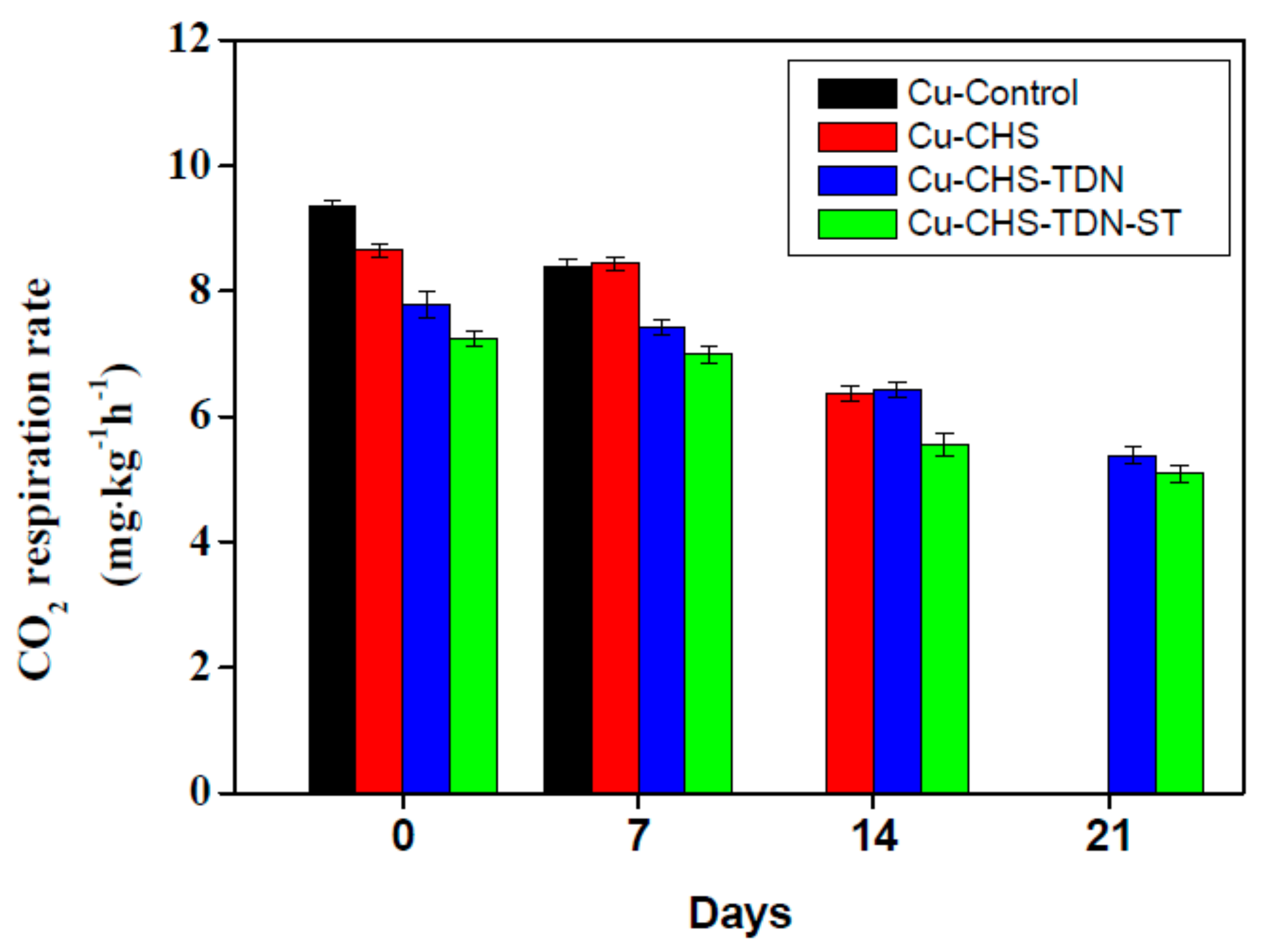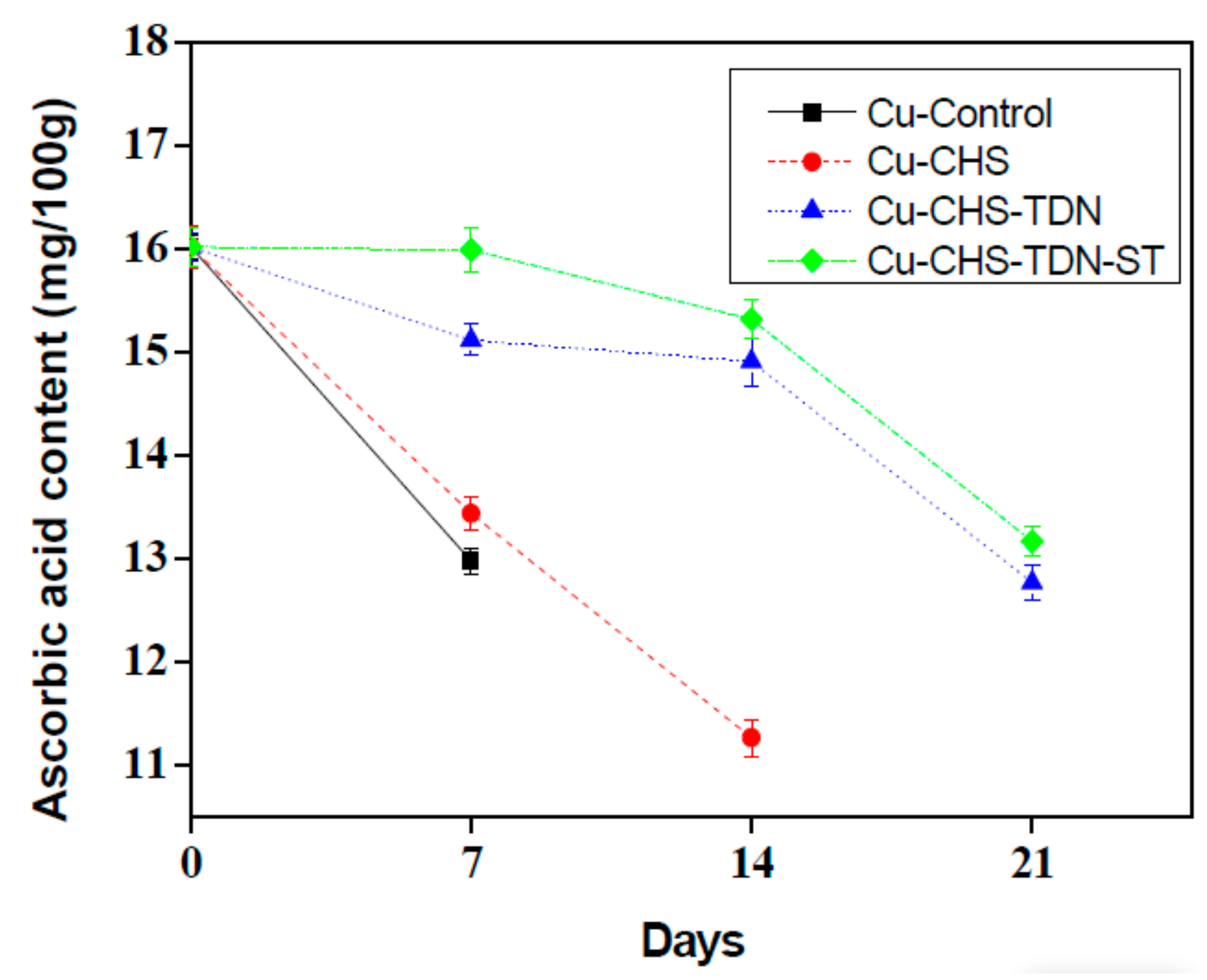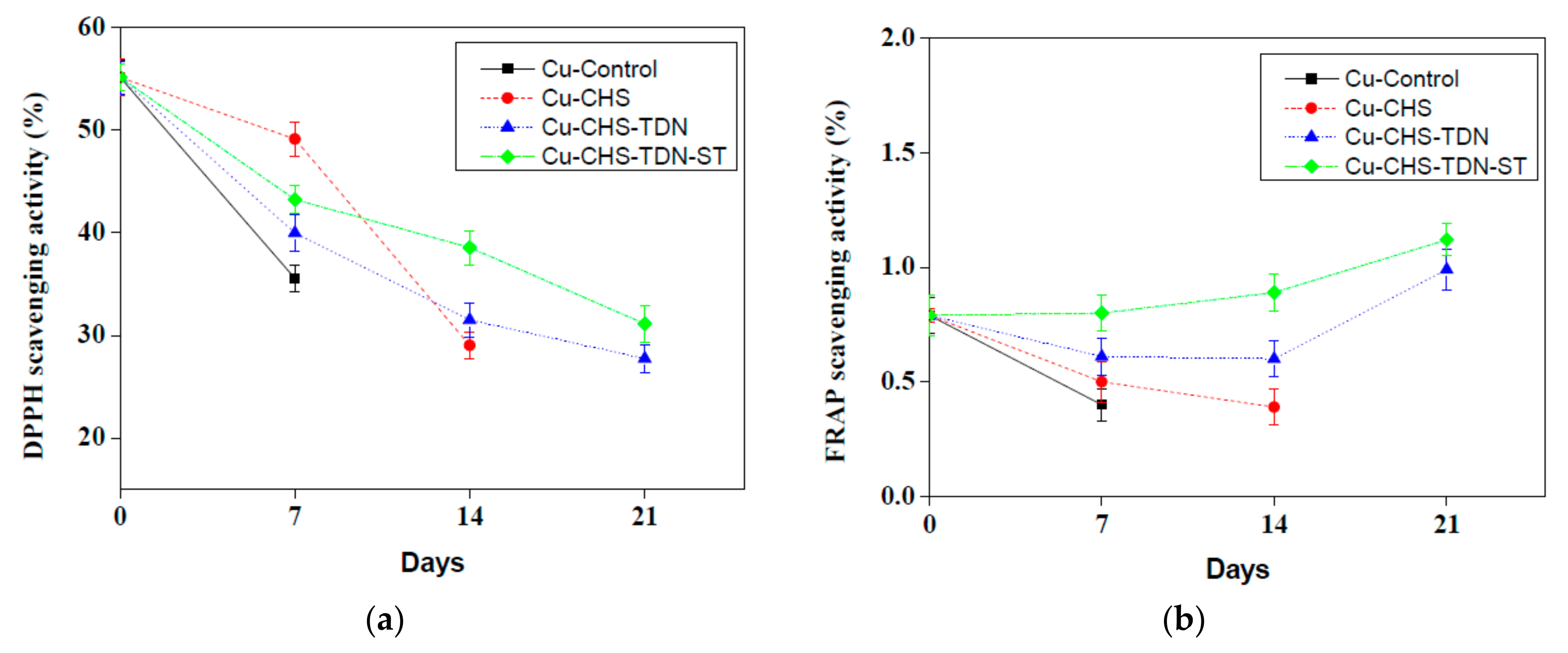Postharvest Physicochemical Properties and Fungal Populations of Treated Cucumber with Sodium Tripolyphosphate/Titanium Dioxide Nanoparticles during Storage
Abstract
1. Introduction
2. Materials and Methods
2.1. Coating Materials
2.2. Plant Materials and Coating Processes
2.3. Chilling Injury
2.4. CO2 Respiration Rate
2.5. Chlorophyll Contents
2.6. Ascorbic Acid Content
2.7. Total Phenolic Content
2.8. Antioxidant Activity
2.9. Peroxidase Enzyme Activity
2.10. Fungal Populations
2.11. Statistical Analysis
3. Results and Discussion
3.1. Chilling Injury
3.2. Respiration Rate
3.3. Chlorophyll Contents
3.4. Ascorbic Acid Content
3.5. Total Phenolic Content
3.6. Antioxidant Activity
3.7. Peroxidase Enzyme Activity
3.8. Fungal Populations
4. Conclusions
Author Contributions
Funding
Institutional Review Board Statement
Informed Consent Statement
Data Availability Statement
Acknowledgments
Conflicts of Interest
References
- Olawuyi, I.F.; Lee, W. Influence of chitosan coating and packaging materials on the quality characteristics of fresh-cut cucumber. Korean J. Food Preserv. 2019, 26, 371–380. [Google Scholar] [CrossRef]
- Reddy, P.P. Bacterial Diseases and Their Management. In Sustainable Crop Protection under Protected Cultivation; Springer: Berlin/Heidelberg, Germany, 2016; pp. 153–159. [Google Scholar]
- Wang, C.Y. Chilling injury of fruits and vegetables. Food Rev. Int. 1989, 5, 209–236. [Google Scholar] [CrossRef]
- Gutiérrez-Pacheco, M.M.; Ortega-Ramírez, L.A.; Silva-Espinoza, B.A.; Cruz-Valenzuela, M.R.; González-Aguilar, G.A.; Lizardi-Mendoza, J.; Miranda, R.; Ayala-Zavala, J.F. Individual and combined coatings of chitosan and carnauba wax with oregano essential oil to avoid water loss and microbial decay of fresh cucumber. Coatings 2020, 10, 614. [Google Scholar] [CrossRef]
- El ghaouth, A.; Arul, J.; Ponnampalam, R.; Boulet, M. Use of chitosan coating to reduce water loss and maintain quality of cucumber and bell pepper fruits. J. Food Process. Preserv. 1991, 15, 359–368. [Google Scholar] [CrossRef]
- Sami, R.; Elhakem, A.; Alharbi, M.; Benajiba, N.; Almatrafi, M.; Jing, J.; Helal, M. Effect of titanium dioxide nanocomposite material and antimicrobial agents on mushrooms shelf-life preservation. Processes 2020, 8, 1632. [Google Scholar] [CrossRef]
- Eldib, R. Application of Nano-coating and Chitosan Combination Films on Cantaloupe Preservation. Pak. J. Biol. Sci. 2020, 23, 1037–1043. [Google Scholar] [CrossRef] [PubMed]
- Eldib, R.; Khojah, E.; Elhakem, A.; Benajiba, N.; Helal, M. Chitosan, nisin, silicon dioxide nanoparticles coating films effects on blueberry (vaccinium myrtillus) quality. Coatings 2020, 10, 962. [Google Scholar] [CrossRef]
- Rokayya, S.; Jia, F.; Li, Y.; Nie, X.; Xu, J.; Han, R.; Yu, H.; Amanullah, S.; Almatrafi, M.M.; Helal, M. Application of nano-titanum dioxide coating on fresh Highbush blueberries shelf life stored under ambient temperature. LWT 2021, 137, 110422. [Google Scholar] [CrossRef]
- Li, Y.; Rokayya, S.; Jia, F.; Nie, X.; Xu, J.; Elhakem, A.; Almatrafi, M.; Benajiba, N.; Helal, M. Shelf-life, quality, safety evaluations of blueberry fruits coated with chitosan nano-material films. Sci. Rep. 2021, 11, 55. [Google Scholar] [CrossRef]
- Sami, R.; Elhakem, A.; Alharbi, M.; Benajiba, N.; Almatrafi, M.; Abdelazez, A.; Helal, M. Evaluation of antioxidant activities, oxidation enzymes, and quality of nano-coated button mushrooms (Agaricus bisporus) during storage. Coatings 2021, 11, 149. [Google Scholar] [CrossRef]
- Zhou, Y.; Teng, F.; Tian, T.; Sami, R.; Wu, C.; Zhu, Y.; Zheng, L.; Jiang, L.; Wang, Z.; Li, Y. The impact of soy protein isolate-dextran conjugation on capsicum oleoresin (Capsicum annuum L.) nanoemulsions. Food Hydrocoll. 2020, 108, 105818. [Google Scholar] [CrossRef]
- Moll, J.; Okupnik, A.; Gogos, A.; Knauer, K.; Bucheli, T.D.; van der Heijden, M.G.A.; Widmer, F. Effects of titanium dioxide nanoparticles on red clover and its rhizobial symbiont. PLoS ONE 2016, 11, e0155111. [Google Scholar] [CrossRef] [PubMed]
- Rokayya, S.; Khojah, E.; Elhakem, A.; Benajiba, N.; Chavali, M.; Vivek, K.; Iqbal, A.; Helal, M. Investigating the nano-films effect on physical, mechanical properties, chemical changes, and microbial load contamination of white button mushrooms during storage. Coatings 2021, 11, 44. [Google Scholar] [CrossRef]
- Hafez, E.M.; Osman, H.S.; Gowayed, S.M.; Okasha, S.A.; Omara, A.E.; Sami, R.; Abd El-Monem, A.M.; Abd El-Razek, U.A. Minimizing the Adversely Impacts of Water Deficit and Soil Salinity on Maize Growth and Productivity in Response to the Application of Plant Growth-Promoting Rhizobacteria and Silica Nanoparticles. Agronomy-Basel. Agronomy 2021, 11, 676. [Google Scholar] [CrossRef]
- Sami, R.; Elhakem, A.; Almushhin, A.; Alharbi, M.; Almatrafi, M.; Benajiba, N.; Fikry, M.; Helal, M. Enhancement in physicochemical parameters and microbial populations of mushrooms as influenced by nano-coating treatments. Sci. Rep. 2021, 11, 7915. [Google Scholar] [CrossRef]
- Shah, B.R.; Li, Y.; Jin, W.; An, Y.; He, L.; Li, Z.; Xu, W.; Li, B. Preparation and optimization of Pickering emulsion stabilized by chitosan-tripolyphosphate nanoparticles for curcumin encapsulation. Food Hydrocoll. 2016, 52, 369–377. [Google Scholar] [CrossRef]
- Saad, M.M. Effect of some postharvest treatments on reducing chilling injury of cucumber fruits during cold storage. J. Ann. Agric. Sci. Moshtohor. 2019, 57, 455–468. [Google Scholar] [CrossRef][Green Version]
- İbrahim, K.; Serhat, U. Improving postharvest storage quality of cucumber fruit by modified atmosphere packaging and biomaterials. HortScience Horts 2019, 54, 2005–2014. [Google Scholar] [CrossRef]
- Sami, R.; Elhakem, A.; Alharbi, M.; Benajiba, N.; Fikry, M.; Helal, M. The combined effect of coating treatments to nisin, nano-silica, and chitosan on oxidation processes of stored button mushrooms at 4 °C. Sci. Rep. 2021, 11, 6031. [Google Scholar] [CrossRef]
- Moalemiyan, M.; Ramaswamy, H.S. Quality retention and shelf-life extension in mediterranean cucumbers coated with a pectin-based film. J. Food Res. 2012, 1, 159–168. [Google Scholar] [CrossRef]
- Sami, R.; Almatrafi, M.; Elhakem, A.; Alharbi, M.; Benajiba, N.; Helal, M. Effect of nano silicon dioxide coating films on the quality characteristics of fresh-cut cantaloupe. Membranes 2021, 11, 140. [Google Scholar] [CrossRef] [PubMed]
- Feng, H.X.; Sam, R.; Jiang, L.Z.; Li, Y.; Cao, W.M. High-performance size-exclusion chromatography studies on the formation and distribution of polar compounds in camellia seed oil during heating. J. Zhejiang Univ. Sci. B 2016, 17, 882–891. [Google Scholar] [CrossRef] [PubMed]
- Qiao, G.H.; Wenxin, D.; Zhigang, X.; Sami, R.; Khojah, E.; Amanullah, S. Antioxidant and anti-inflammatory capacities of pepper tissues. Ital. J. Food Sci. 2020, 32, 265–274. [Google Scholar]
- Elhakem, A.H.; Almatra, M.M.; Benajiba, N.; Koko, M.Y.; Sami, R. Comparative analysis of bioactive compounds, antioxidant and anti-inflammatory activities of apple varieties. Asian J. Plant Sci. 2020, 20, 61–66. [Google Scholar] [CrossRef]
- Qiao, G.; Xiao, Z.; Ding, W.; Rok, A. Effect of chitosan/nano-titanium dioxide/thymol and tween films on ready-to-eat cantaloupe fruit quality. Coatings 2019, 9, 828. [Google Scholar] [CrossRef]
- Olawuyi, I.F.; Park, J.J.; Lee, J.J.; Lee, W.Y. Combined effect of chitosan coating and modified atmosphere packaging on fresh-cut cucumber. Food Sci. Nutr. 2019, 7, 1043–1052. [Google Scholar] [CrossRef] [PubMed]
- Sami, R.; Khojah, E.; Elhakem, A.; Benajiba, N.; Helal, M.; Alhuthal, N.; Alzahrani, S.A.; Alharbi, M.; Chavali, M. Performance study of nano/SiO2 films and the antimicrobial application on cantaloupe fruit shelf-life. Appl. Sci. 2021, 11, 3879. [Google Scholar] [CrossRef]
- Sami, R.; Soltane, S.; Helal, M. Microscopic image segmentation and morphological characterization of novel chitosan/silica nanoparticle/nisin films using antimicrobial technique for blueberry preservation. Membranes 2021, 11, 303. [Google Scholar] [CrossRef]
- Mohamed, M.A.A.; El-Khalek, A.F.A.; Elmehrat, H.G.; Mohamed, G.A. Pre-storage application of antioxidant alleviates chilling injury and maintains quality of Valencia orange fruit stored at low temperature. Egypt. J. Hortic. 2016, 43, 175–193. [Google Scholar] [CrossRef][Green Version]
- Ghidelli, C.; Mateos, M.; Rojas-Argudo, C.; Pérez-Gago, M.B. Extending the shelf life of fresh-cut eggplant with a soy protein–cysteine based edible coating and modified atmosphere packaging. Postharvest Biol. Technol. 2014, 95, 81–87. [Google Scholar] [CrossRef]
- Rokayya, S.; Garsa, A.; Eman, E.; Helal, M. Saudi community care awareness food facts, nutrients, immune system and covid-19 prevention in taif city among different age categories. Afr. J. Food Agric. Nutr. Dev. 2021, 21, 17213–17233. [Google Scholar] [CrossRef]
- Sami, R.A.; Khojah, E.Y.; Elgarni, E.A.; Benajiba, N. Evaluation of nutritional status for some sensitive sets and its relationship to natural antioxidants. J. King Abdulaziz Univ. Med Sci. 2017, 24, 1–9. [Google Scholar] [CrossRef]
- El-din, H.; Anean, H.A.; Aly, H.H. Effect of some edible coatings on storability of organic cucumber fruit. Egypt. J. Agric. Res. 2015, 93, 1013–1029. [Google Scholar]
- Sami, R.; Li, Y.; Qi, B.; Wang, S.; Zhang, Q.; Han, F.; Ma, Y.; Jing, J.; Jiang, L. HPLC analysis of water-soluble vitamins (B2, B3, B6, B12, and C) and fat-soluble vitamins (E, K, D, A, and β-Carotene) of okra (Abelmoschus esculentus). J. Chem. 2014, 2014, 831357. [Google Scholar] [CrossRef]
- Sami, R.; Elhakem, A.; Alharbi, M.; Benajiba, N.; Almatrafi, M.; Helal, M. Nutritional values of onion bulbs with some essential structural parameters for packaging process. Appl. Sci. 2021, 11, 2317. [Google Scholar] [CrossRef]
- Rokayya, S.; Li, C.J.; Zhao, Y.; Li, Y.; Sun, C.H. Cabbage (Brassica oleracea L. var. capitata) phytochemicals with antioxidant and anti-inflammatory potential. Asian Pac. J. Cancer Prev. 2013, 14, 6657–6662. [Google Scholar] [CrossRef]
- Vallverdú-Queralt, A.; Arranz, S.; Medina-Remón, A.; Casals-Ribes, I.; Lamuela-Raventós, R.M. Changes in phenolic content of tomato products during storage. J. Agric. Food Chem. 2011, 59, 9358–9365. [Google Scholar] [CrossRef] [PubMed]
- Camargo, J.M.; Dunoyer, A.T.; García-Zapateiro, L.A. The effect of storage temperature and time on total phenolics and enzymatic activity of sapodilla (Achras sapota L.). Rev. Fac. Nac. Agron. Medellín 2016, 69, 7955–7963. [Google Scholar] [CrossRef]
- Sami, R. Antioxidant properties of peptides from soybean meal protein hydrolysates evaluated by electron spin resonance spectrometry. Adv. Environ. Biol. 2017, 11, 12–18. [Google Scholar]
- Elhake, A.H.; Benajiba, N.; Koko, M.Y.; Khojah, E.; Rok, A. DPPH, FRAP and TAEC assays with postharvest cabbage (Brassica oleracea) parameters during the packaging process. Pak. J. Biol. Sci. 2021, 24, 182–187. [Google Scholar] [CrossRef]
- Wang, H.; Sun, Y.; Li, Y.; Tong, X.; Regenstein, J.M.; Huang, Y.; Ma, W.; Sami, R.; Qi, B.; Jiang, L. Effect of the condition of spray-drying on the properties of the polypeptide-rich powders from enzyme-assisted aqueous extraction processing. Dry. Technol. 2019, 37, 2105–2115. [Google Scholar] [CrossRef]
- Khojah, E.Y.; Sami, R. Fatty acids composition and oxidative stability of peanut and sesame oils with the sensory evaluation of mayonnaise prepared by different oils. Assiut J. Agric. Sci. 2016, 47, 460–472. [Google Scholar]
- Walkowiak-Tomczak, D.; Idaszewska, N.; Bieńczak, K.; Kómoch, W. The effect of mechanical actions occurring during transport on physicochemical changes in Agaricus bisporus mushrooms. Sustainability 2020, 12, 4993. [Google Scholar] [CrossRef]
- Zhang, Y.; Zhang, M.; Yang, H. Postharvest chitosan-g-salicylic acid application alleviates chilling injury and preserves cucumber fruit quality during cold storage. Food Chem. 2015, 174, 558–563. [Google Scholar] [CrossRef] [PubMed]
- Zhao, Y.; Mingfeng, C.; Aiqiang, C.; Na, Z.; Songsong, Z. Analysis about heat transfer of vegetables during cold shock treatment and preservation quality after storage. J. Int. J. Food Eng. 2017, 13. [Google Scholar] [CrossRef]
- Koh, P.C.; Noranizan, M.A.; Karim, R.; Nur Hanani, Z.A.; Rosli, S.Z.; Hambali, N.H. Enzymatic activity of alginate coated and pulsed light treated fresh-cut cantaloupes (Cucumis melo L. var. reticulatus cv. Glamour) during chilled storage. Int. Food Res. J. 2019, 26, 547–556. [Google Scholar]
- Waewthongrak, W.; Pisuchpen, S.; Leelasuphakul, W. Effect of bacillus subtilis and chitosan applications on green mold (Penicilium digitatum Sacc.) decay in citrus fruit. Postharvest Biol. Technol. 2015, 99, 44–49. [Google Scholar] [CrossRef]






| Days | Cu-Control | Cu-CHS | Cu-CHS-TDN | Cu-CHS-TDN-ST |
|---|---|---|---|---|
| Clorophyll a (mg/g) | ||||
| 0 | 0.23 ± 0.01 c | 0.24 ± 0.03 c | 0.32 ± 0.02 b | 0.34 ± 0.01 a |
| 7 | 0.17 ± 0.02 d | 0.22 ± 0.02 c | 0.26 ± 0.03 b | 0.28 ± 0.03 a |
| 14 | - | 0.20 ± 0.01 b | 0.27 ± 0.02 a | 0.27 ± 0.02 a |
| 21 | - | - | 0.24 ± 0.01 a | 0.25 ± 0.03 a |
| Clorophyll b (mg/g) | ||||
| 0 | 0.10 ± 0.03 d | 0.12 ± 0.01 c | 0.16 ± 0.02 b | 0.21 ± 0.01 a |
| 7 | 0.09 ± 0.02 d | 0.11 ± 0.02 c | 0.14 ± 0.03 b | 0.17 ± 0.02 a |
| 14 | - | 0.08 ± 0.03 c | 0.12 ± 0.01 b | 0.14 ± 0.02 a |
| 21 | - | - | 0.11 ± 0.02 b | 0.13 ± 0.03 a |
| Days | Cu-Control | Cu-CHS | Cu-CHS-TDN | Cu-CHS-TDN-ST |
|---|---|---|---|---|
| 0 | 2.08 ± 0.21 a | 2.08 ± 0.13 a | 2.08 ± 0.12 a | 2.08 ± 0.15 a |
| 7 | 3.91 ± 0.11 a | 2.31 ± 0.14 c | 2.87 ± 0.18 b | 2.17 ± 0.11 d |
| 14 | - | 3.85 ± 0.11 a | 3.15 ± 0.14 b | 2.98 ± 0.13 c |
| 21 | - | - | 3.77 ± 0.19 a | 3.15 ± 0.17 b |
Publisher’s Note: MDPI stays neutral with regard to jurisdictional claims in published maps and institutional affiliations. |
© 2021 by the authors. Licensee MDPI, Basel, Switzerland. This article is an open access article distributed under the terms and conditions of the Creative Commons Attribution (CC BY) license (https://creativecommons.org/licenses/by/4.0/).
Share and Cite
Khojah, E.; Sami, R.; Helal, M.; Elhakem, A.; Benajiba, N.; Alkaltham, M.S.; Salamatullah, A.M. Postharvest Physicochemical Properties and Fungal Populations of Treated Cucumber with Sodium Tripolyphosphate/Titanium Dioxide Nanoparticles during Storage. Coatings 2021, 11, 613. https://doi.org/10.3390/coatings11060613
Khojah E, Sami R, Helal M, Elhakem A, Benajiba N, Alkaltham MS, Salamatullah AM. Postharvest Physicochemical Properties and Fungal Populations of Treated Cucumber with Sodium Tripolyphosphate/Titanium Dioxide Nanoparticles during Storage. Coatings. 2021; 11(6):613. https://doi.org/10.3390/coatings11060613
Chicago/Turabian StyleKhojah, Ebtihal, Rokayya Sami, Mahmoud Helal, Abeer Elhakem, Nada Benajiba, Mohammed Saeed Alkaltham, and Ahmad Mohammad Salamatullah. 2021. "Postharvest Physicochemical Properties and Fungal Populations of Treated Cucumber with Sodium Tripolyphosphate/Titanium Dioxide Nanoparticles during Storage" Coatings 11, no. 6: 613. https://doi.org/10.3390/coatings11060613
APA StyleKhojah, E., Sami, R., Helal, M., Elhakem, A., Benajiba, N., Alkaltham, M. S., & Salamatullah, A. M. (2021). Postharvest Physicochemical Properties and Fungal Populations of Treated Cucumber with Sodium Tripolyphosphate/Titanium Dioxide Nanoparticles during Storage. Coatings, 11(6), 613. https://doi.org/10.3390/coatings11060613






